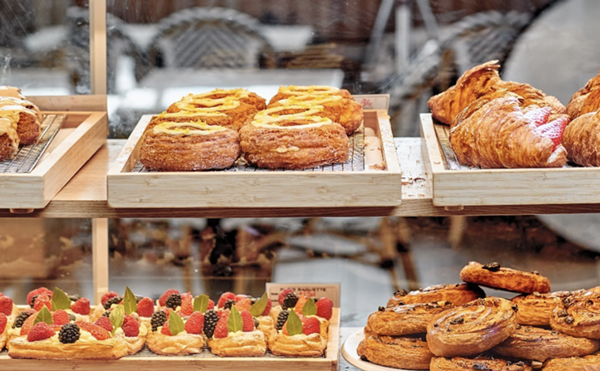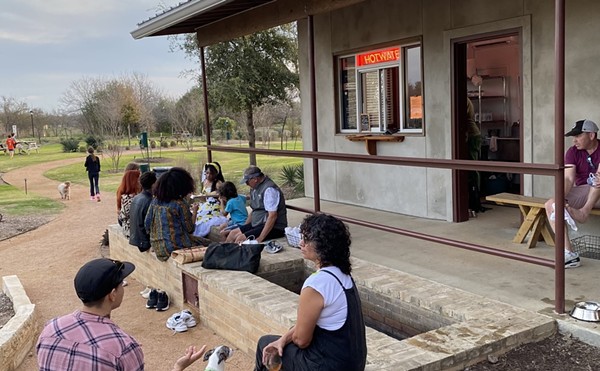| The recent E. coli and spinach scare may bolster farmers who sell to local markets. |
Some blame the cattle feedlots upstream from where the contaminated spinach may have been grown. Such operations are breeding grounds for this strain of E. coli, which in recent years has been linked to other outbreaks, mostly beef-borne. These feedlots, say the beef-blamers, contaminated the groundwater that irrigated the spinach.
Then there are the organic-blamers, who contend that organic-farming practices, which employ cow manure instead of biologically sterile chemical fertilizers, are to blame. The cow manure was incompletely composted, the organic-blamers speculate, and thus sufficient heat to kill the microbes was not generated.
At press time, investigations seem close to vindicating organic spinach, but all bagged spinach remains high-risk in the eyes of the USDA. At the farmers’ markets, meanwhile, spinach is flying off the tables, as is loose-leaf spinach grown locally and labeled as such at the store. It doesn’t matter if the spinach is certified organic or not. What matters is that it was grown close to home, and not in California.
And while it has yet to be determined whether the source of this outbreak was organic or conventional spinach, Natural Selection Foods — which distributes both organic and non-organic produce — has remained a central focus. Some investigators suspect the wash water in their processing facility.
Thus, in terms of food safety, we have the big organic and big conventional producers in faraway California perched squarely in the “unsafe” camp, while the small organic and small conventional producers close to home are considered by consumers — rightly so — to be safe.
I’m not suggesting that organic is no better than non-organic. All other factors being equal, I would always choose the organic option. But I am suggesting that the distance from home that a foodstuff is grown, and the scale of the operation that grows it, can be more important than whether it’s certified organic. In the case of the current E. coli outbreak, I’m not alone. And one group of farmers in Montana is reaping the benefits.
Twelve western Montana farms have banded together to form the Montana Sustainable Growers Union, and they market their produce under the Homegrown label, which guarantees the product was grown locally, ecologically, and in a healthy farming community using fair-labor practices. This, members say, more accurately reflects their product than would a USDA Certified Organic label.
“What we as small farmers took for granted, that organic means small and local, is gone,” says Josh Slotnick of Clark Fork Organics, which has dropped its USDA Organic certification after 14 years. “The label that describes tomatoes flown 2,000 miles from a 3,000-acre monoculture worked by migrant workers who don’t make a living wage doesn’t describe the food my family grows.”
Such mega-monocultures are a byproduct of the increasing public demand for organic produce. Most of this demand is generated by self-centered notions that eating organic is better for your body, and doesn’t much attach to the fact that organic practices tend to be lighter on the surrounding ecosystems as well. Because of this demand, corporations like Philip Morris/Kraft, Nestlé, Kellogg, ConAgra, Coca-Cola, and others have jumped on the organic bandwagon. In the process of paving themselves a road to the $14-billion-a-year organic-food sales trough, big organic has changed the rules of organic agriculture, snatching it from the calloused hands of the small farmers who created the demand for organic in the first place as a byproduct of their attempts to save the world through farming.
“Organic certification now amounts to a fundamental acceptance of a system and culture that I don’t want to be a part of,” explains Homegrown member Steve Elliot of Lifeline Farms, who has farmed organically for 25 years, but no longer certifies.
And while the Homegrown folks are hardly the only farmers dissatisfied with the corporate takeover of organic, they are, nonetheless, a leading edge in the movement to somewhere else. What separates the Homegrown-ers from untold legions of idealistic earth-friendly growers is that the Montana Sustainable Growers Union has codified their values in a pledge to which members are actively holding each other via yearly inspections.
Between restaurants, grocery stores, CSA memberships, and farmers’ markets, Homegrown farmers were already consistently selling their food back when they were certified organic, and nobody is switching to Homegrown in hopes of grabbing a bigger market share.
And while the recent E. coli outbreak isn’t going to have a lifestyle-changing impact on any farmer’s finances, it is, nonetheless, a signal from the universe that the Homegrowners’ switch is timely. Rising fuel costs, which will make shipping more expensive, and an increase in instances of E. coli and mad-cow disease, which give the public more reason to be suspicious of foods grown in faraway places, certainly aren’t hurting the Homegrown farmers. And consumers, who can look their farmer in the eye, can keep eating their spinach.
You can find locally grown and produced food in Texas at your local farmers’ markets (see Ams.usda.gov/farmersmarkets/States/Texas.htm for a directory) and by visiting the Texas Department of Agriculture’s Gotexan.org website, which includes a searchable database of producers and products. Whole Foods in the Quarry Market implemented a Go Local program this spring that encourages customers to recommend local products (like the decadent Pure Luck goat cheeses, produced in Dripping Springs) for the store, and Piatti Locali, also in the Quarry, uses locally grown produce in many of their dishes (identified on the menu).


















